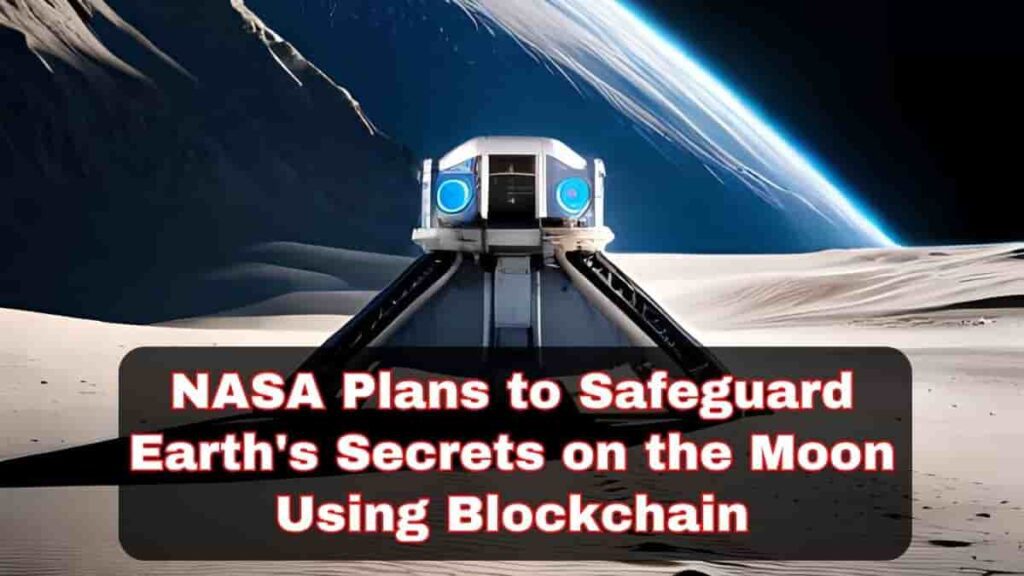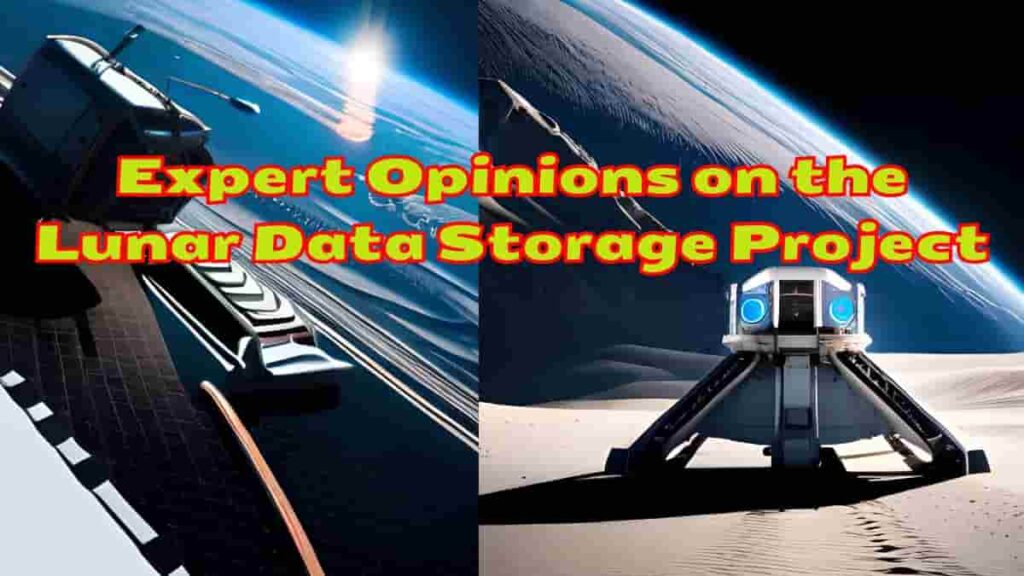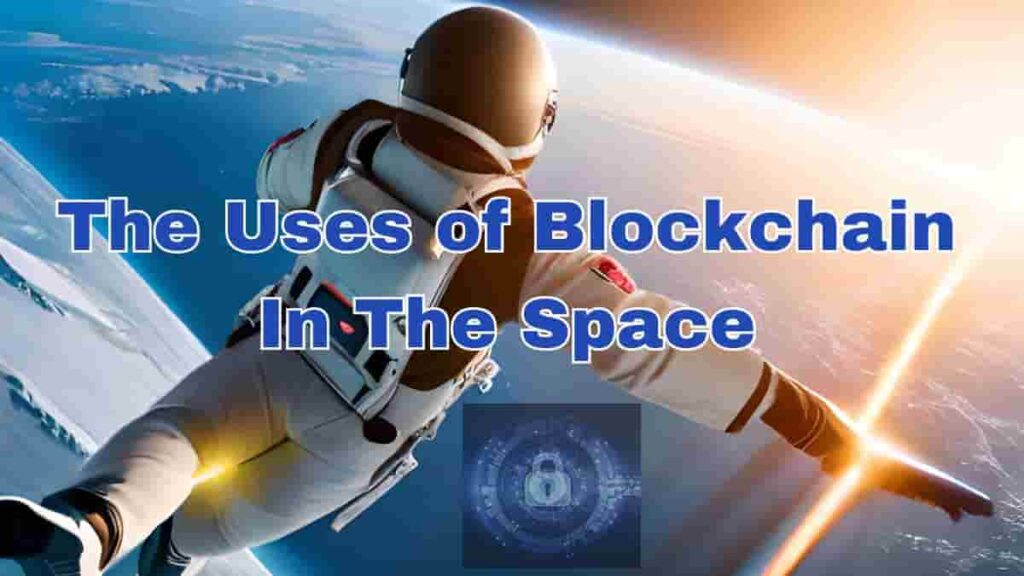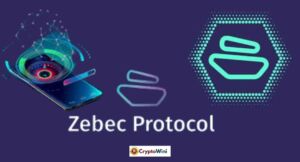
NASA Safeguarding Earth’s Knowledge for an Uncertain Future : Protecting Earth’s Secrets with Blockchain
Space agency NASA, in collaboration with computer startup Lonestar and the Isle of Man, is embarking on a groundbreaking endeavor: utilizing blockchain technology to securely store data on the moon. This visionary initiative aims to create an immutable record of lunar missions, preserving essential information about spacecraft, cargo, and mission objectives. By employing blockchain’s distributed ledger technology, this venture promises enhanced data accuracy and transparency for organizations and space agencies engaged in lunar exploration.
Preserving Earth’s Secrets
In an era where the future habitability of our planet is uncertain, safeguarding essential knowledge becomes paramount. This innovative collaboration seeks to secure Earth’s secrets, ensuring their preservation in case our planet becomes uninhabitable.
Blockchain: A Game-Changing Technology
Blockchain technology has emerged as a game-changer across various industries. From revolutionizing the gaming sector to disrupting traditional businesses, its potential knows no bounds.
Expert Opinions on the Lunar Data Storage Project
Kurt Roosen, Head of Innovation at Digital Isle of Man, expressed the importance of this project, stating, “In history, we’ve seen several circumstances where perceived bodies of knowledge have been lost or cultures have disappeared.” He underlined the significance of preserving our knowledge for future generations.

The first phase of the project involves testing the storage capacity with stamps from the Isle of Man. In February 2024, a lunar data cube will embark on a journey to the moon. This black rectangular device will carry a terabyte of data and be powered by solar energy.
Roosen elaborated, “It could sit there forever,” highlighting the sustainability of this solution compared to terrestrial storage options. However, not everyone shares Roosen’s enthusiasm.
Prof. Peter Bentley, a computer scientist at University College London, raised concerns about the project’s cost-effectiveness. He suggested that better storage solutions can be found on Earth, likening the endeavor to “throwing a bottle containing a thumb drive into the sea.”
For more detail please watch this video of our YouTube Channel “CRYPTOWINI” and Subscribe our Channel for the regular new videos of Cryptocurrency world :
Debating Lunar Data Security
The core of the debate revolves around lunar data security. Roosen argued that data on the moon is inherently secure because hackers would need to physically access the lunar surface to compromise it.
However, Bentley contested this notion, emphasizing that data breaches are not solely determined by proximity. He pointed out that if one can connect to the data, breach encryption and security, then the data becomes vulnerable.
Challenges and Opportunities
Roosen acknowledged the challenges but welcomed them, describing them as “a really interesting challenge, not just for us, but for NASA.” He noted that skeptics often question the authenticity of the moon missions, making the project’s success all the more crucial.
As the three organizations press forward with their pioneering plans, it’s essential to recognize the complex technological and logistical obstacles associated with applying blockchain technology in space. Overcoming issues such as creating and maintaining a network infrastructure, addressing data transmission latency, and ensuring the security and durability of blockchain systems in the harsh space environment will be formidable tasks.
Furthermore, any blockchain application in space activities will likely require international coordination, regulatory frameworks, and agreements among spacefaring countries and organizations.

Unmasking the Secrets of Blockchain Security: What You MUST Know to Stay Safe in the Digital Jungle!
Blockchain security is a critical aspect of blockchain technology, ensuring the integrity, confidentiality, and availability of data and transactions within a blockchain network. It employs various mechanisms and features to protect against threats and vulnerabilities. Here are key components of blockchain security:
- Decentralization: One of the foundational principles of blockchain security is decentralization. Unlike centralized systems, where a single point of failure can compromise the entire network, blockchain operates on a distributed network of nodes. This redundancy makes it exceptionally difficult for a single entity or attacker to manipulate or control the network.
- Cryptography: Blockchain relies heavily on cryptographic techniques to secure data. Public key cryptography ensures that only authorized participants can access and validate transactions. Hash functions are used to create fixed-length, irreversible representations of data, making it tamper-resistant.
- Consensus Mechanisms: Consensus algorithms like Proof of Work (PoW) and Proof of Stake (PoS) ensure that network participants agree on the validity of transactions. PoW, for instance, requires participants to solve complex mathematical puzzles, making it computationally expensive to launch attacks.
- Immutability: Once data is recorded in a blockchain, it becomes nearly impossible to alter or delete. This immutability is achieved through cryptographic hashing and the chronological chaining of blocks, ensuring the integrity of historical transactions.
- Permissioned and Permissionless Networks: Blockchain networks can be permissioned (private) or permissionless (public). Permissioned blockchains restrict participation to authorized entities, enhancing control and privacy. Permissionless blockchains, like Bitcoin and Ethereum, allow anyone to join, emphasizing transparency.
- Digital Signatures: Digital signatures, generated using private keys, authenticate the identity of participants in a blockchain network. Transactions are signed with private keys and verified with corresponding public keys, ensuring that only authorized parties can make changes.
- Network Security: Blockchain networks are vulnerable to network-layer attacks, such as Distributed Denial of Service (DDoS) attacks. Robust network security measures, including firewalls and intrusion detection systems, protect against these threats.
- Smart Contract Security: Smart contracts are self-executing agreements that run on the blockchain. Ensuring the security of smart contracts is crucial to prevent vulnerabilities or exploits. Auditing, formal verification, and secure coding practices are employed to minimize risks.
- Private Keys Management: Safeguarding private keys is essential to prevent unauthorized access to wallets and accounts. Hardware wallets, secure key storage, and multi-signature authentication are employed to protect private keys.
- Security Audits: Regular security audits and vulnerability assessments are conducted on blockchain networks and smart contracts. This helps identify and address potential weaknesses or vulnerabilities before they can be exploited.
- Regulatory Compliance: Blockchain projects often need to adhere to legal and regulatory requirements, including Anti-Money Laundering (AML) and Know Your Customer (KYC) regulations. Compliance measures are integrated into blockchain systems to meet these requirements.
- Data Encryption: Data within blockchain transactions can be encrypted to protect sensitive information. Encryption ensures that even if data is visible on the blockchain, it remains confidential and secure.
- Governance and Consensus Upgrades: Blockchain networks may implement governance mechanisms to decide on protocol upgrades and changes. These mechanisms prevent contentious forks and maintain network stability.
While blockchain security offers robust protection against many threats, it’s not impervious to all risks. Social engineering attacks, vulnerabilities in smart contracts, and governance disputes are examples of challenges that can still affect blockchain networks. Therefore, continuous vigilance, ongoing research, and adherence to best practices are essential to maintaining blockchain security in an ever-evolving landscape.

What are the challenges of lunar data storage?
Lunar data storage presents a unique set of challenges due to the harsh and extraterrestrial environment of the moon. These challenges include:
- Extreme Temperature Variations: The moon experiences extreme temperature variations, with daytime temperatures soaring to over 200 degrees Celsius (392 degrees Fahrenheit) and nighttime temperatures plummeting to as low as -200 degrees Celsius (-328 degrees Fahrenheit). These extreme temperature swings can potentially damage electronic components and storage media.
- Radiation Exposure: The moon lacks a protective atmosphere, exposing its surface to high levels of solar and cosmic radiation. Radiation can degrade electronic components and data storage devices over time, leading to data corruption or loss.
- Micro-Meteorite Impact: The lunar surface is constantly bombarded by micro-meteorites, which can puncture spacecraft and infrastructure. These impacts could potentially damage storage devices and compromise data integrity.
- Dust and Regolith: Lunar dust, known as regolith, is abrasive and can infiltrate equipment, causing wear and tear on storage devices. Dust particles can also accumulate on solar panels, affecting power generation for data storage systems.
- Limited Power Sources: Power generation on the moon is primarily reliant on solar panels. Prolonged periods of darkness during lunar nights can pose challenges for maintaining continuous power to data storage devices, potentially leading to data loss or corruption.
- Data Transmission Latency: The vast distance between the moon and Earth results in significant data transmission latency. This delay can affect real-time data access and retrieval, making it less practical for certain applications.
- Limited Maintenance Opportunities: Unlike on Earth, where infrastructure and equipment can be readily maintained or replaced, the moon’s remoteness makes maintenance and repairs challenging. This means that any issues with data storage systems may be difficult or impossible to address.
- Security Risks: While the moon’s remote location may deter physical access to data storage, the security of data in transit between Earth and the moon remains a concern. Data encryption and secure transmission protocols will be critical to prevent unauthorized access.
- International Cooperation: Any long-term lunar data storage project would likely require international cooperation and agreements among spacefaring nations. Coordinating such efforts can be complex and require diplomatic negotiations.
- Cost and Sustainability: Establishing and maintaining data storage infrastructure on the moon comes with significant costs. Ensuring the long-term sustainability of these systems and justifying the expenses will be a considerable challenge.
Addressing these challenges will be crucial for the successful implementation of lunar data storage solutions, especially if they are intended to preserve essential information for future generations or serve as a backup for critical data from Earth.

What other uses for blockchain are there in space?
Blockchain technology offers several potential applications in space exploration and related activities, thanks to its characteristics such as decentralization, security, and immutability. Here are some of the key uses for blockchain in space:
- Secure Data Storage: Beyond lunar data storage, blockchain can be employed to securely store sensitive data related to space missions, scientific research, and spacecraft operations. The immutability of blockchain ensures data integrity and protection from unauthorized access.
- Supply Chain Management: Blockchain can be used to track the supply chain of components and materials used in the construction of spacecraft and equipment. This ensures transparency, traceability, and authenticity of the components, reducing the risk of counterfeit parts compromising mission success.
- Satellite Communication: Blockchain can enhance the security and efficiency of satellite communication systems. It can be used to authenticate and secure data transmissions between satellites, ground stations, and other spacecraft, reducing the risk of data breaches or tampering.
- Navigation and Positioning: Blockchain technology can support global navigation and positioning systems, enhancing the accuracy and reliability of satellite-based navigation systems like GPS. It can help protect against spoofing and other forms of interference.
- Space Resource Management: In the context of asteroid mining and resource utilization in space, blockchain can be used to track ownership and transactions related to space resources, ensuring fair distribution and adherence to international regulations.
- Smart Contracts for Space Missions: Smart contracts, which are self-executing agreements with predefined rules, can be used to automate various aspects of space missions, including payment disbursements, mission planning, and execution of tasks. This reduces the need for intermediaries and minimizes the risk of errors.
- Space Traffic Management: Blockchain can facilitate the secure exchange of data and information among various space actors, including satellite operators, space agencies, and commercial entities. This can aid in space traffic management and collision avoidance.
- Scientific Research Collaboration: Blockchain can be used to create secure and transparent platforms for collaborative scientific research in space. Researchers from different organizations and countries can securely share data and findings while maintaining data integrity and attribution.
- Tokenization of Space Assets: Blockchain-based tokens can represent ownership or shares in space assets, such as satellites, lunar landers, or space habitats. This enables fractional ownership and investment opportunities in the burgeoning space industry.
- Space Tourism and Entertainment: Blockchain can enhance the booking, payment, and authentication processes for space tourism experiences. It can also be used to create decentralized platforms for space-related entertainment and content distribution.
- Space-Based Financial Services: Blockchain can facilitate financial transactions and services for space-based activities, including microtransactions for satellite data access, insurance for space missions, and crowdfunding for space projects.
- Space Governance and Regulations: Blockchain can support transparent and auditable compliance with space governance and regulatory frameworks. It can help track licenses, permits, and environmental impact assessments for space activities.
While these potential uses for blockchain in space hold promise, they also come with technical, regulatory, and operational challenges. Ensuring the security, scalability, and interoperability of blockchain systems in the space environment will be crucial for their successful adoption in the rapidly evolving space industry.
Frequently Asked Questions (FAQs)
1. What is the goal of NASA’s collaboration with Lonestar and the Isle of Man regarding lunar data storage?
Answer: The goal of this collaboration is to utilize blockchain technology to create an immutable record of lunar missions, preserving essential information about spacecraft, cargo, and mission objectives on the moon. This effort aims to safeguard Earth’s knowledge for an uncertain future.
2. How does blockchain technology enhance data storage for lunar missions?
Answer: Blockchain technology’s distributed ledger system promises enhanced data accuracy, transparency, and security. It creates an unalterable record of lunar mission data, reducing the risk of data loss or manipulation.
3. What are the unique challenges associated with lunar data storage?
Answer: Lunar data storage faces challenges such as extreme temperature variations, radiation exposure, micro-meteorite impacts, limited power sources, data transmission latency, and limited maintenance opportunities due to the moon’s harsh and remote environment.
4. Why are some experts skeptical about the cost-effectiveness of lunar data storage on the moon?
Answer: Critics, like Prof. Peter Bentley, suggest that terrestrial storage solutions may be more cost-effective than launching data storage devices to the moon. They question whether the benefits outweigh the expenses.
5. How secure is data stored on the moon, and what are the security concerns?
Answer: Proponents argue that data on the moon is inherently secure due to the physical inaccessibility of the lunar surface. However, security concerns include data breaches during transmission between Earth and the moon, which requires robust encryption and secure transmission protocols.
6. Besides lunar data storage, what other applications does blockchain have in space exploration?
Answer: Blockchain technology can be applied to enhance supply chain management, satellite communication security, navigation and positioning systems, space resource management, smart contracts for mission automation, and more within the space industry.
7. What is the significance of international collaboration in space-based blockchain applications?
Answer: International coordination, regulatory frameworks, and agreements among spacefaring nations and organizations are vital for the successful implementation of blockchain technology in space. Such collaboration ensures standardized practices, compliance, and shared benefits in space activities.
Conclusion
In conclusion, NASA’s collaboration with Lonestar and the Isle of Man to employ blockchain technology for lunar data storage underscores the critical importance of safeguarding humanity’s knowledge in an era of uncertainty. The project’s visionary ambition to create an immutable record of lunar missions signifies a proactive effort to preserve essential information about space exploration, ensuring its accessibility to future generations.
Blockchain’s versatility emerges as a game-changing technology with boundless potential across various industries, including space exploration. Its distributed ledger capabilities promise heightened data accuracy, transparency, and security, making it a valuable tool for organizations engaged in lunar missions and beyond.
However, the project faces a divergence of perspectives. Proponents emphasize the sustainability and security of lunar data storage, highlighting the inherent security of the moon’s remote location. In contrast, critics raise questions about cost-effectiveness and alternative terrestrial storage solutions. Debates also revolve around the nuanced issue of lunar data security, with considerations of proximity and data transmission vulnerabilities.
The unique challenges posed by lunar data storage, including extreme temperature fluctuations, radiation exposure, and micro-meteorite impacts, underscore the need for innovative solutions to ensure data integrity and longevity in the lunar environment.
Furthermore, blockchain technology’s potential extends beyond lunar storage to revolutionize space-related activities, including supply chain management, satellite communication, navigation, and resource utilization. Nevertheless, successful implementation will require international collaboration and regulatory frameworks.
In this rapidly evolving space landscape, continuous security vigilance and adherence to best practices are essential to mitigate risks associated with blockchain technology. NASA’s pioneering venture signifies not only a commitment to preserving knowledge but also an invitation to address the complex technological, logistical, and security challenges associated with blockchain in space exploration. As this ambitious project progresses, it exemplifies humanity’s dedication to securing its place among the stars while safeguarding the wisdom and achievements of the past.






























